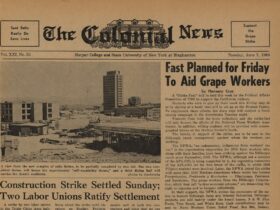
World War II Sketchbooks from the Victor A. Lundy Archive
Photo: Library of Congress Prints and Photographs Division Washington, D.C. 20540 USA http://hdl.loc.gov/loc.pnp/pp.print
A visual diary with 158 pencil sketches brings to life the wartime experience of noted architect Victor A. Lundy, who served in the U.S. 26th Infantry Division during World War II. In 1942, Lundy was 19, studying to be an architect in New York City. Excited about rebuilding Europe post-war, he and other college men enlisted in the Army Special Training Program (ASTP). But, by 1944, with D-Day planned, the Army needed reinforcements, and Lundy and his company were thrown into the infantry. Lundy couldn’t believe it and recalled during an oral history interview that during lectures, he “never listened, I was busy sketching.” But soon, “I sort of took to it. … war experience just hypnotizes young men.”
Lundy applied his drawing skills to what was around him–training at Fort Jackson, South Carolina; forced marches; men at rest; the PX and tents; New York harbor; aboard ship in the Atlantic crossing; Cherbourg harbor; and French villages. Many vivid portraits of fellow soldiers and frontline danger also fill the pages. The sketches cover May to November 1944 when Lundy was wounded, with some gaps where notebooks were lost.
The eight surviving sketchbooks are spiral bound and 3 x 5 inches –small enough to fit in a breast pocket. Lundy used black Hardtmuth leads (a drawing pencil) and sketched quickly. “For me, drawing is sort of synonymous with thinking.”
– Overview from the Library of Congress Prints & Photographs Reading Room.
View all of the drawings here.
Slideshow of sketches.
Victor Alfred Lundy was born in 1923 in New York City. After serving in the U.S. Army during World War II, he completed a degree in architecture at the Harvard University Graduate School of Design. Winning the prestigious Rotch Travelling Scholarship allowed him to travel abroad. In 1954, Lundy opened an architectural firm in Sarasota, Florida. In 1967, the American Institute of Architects named him a Fellow–one of its highest honors. Lundy moved to Houston, Texas, in the 1970s. Among the notable buildings designed by this master artist-architect are churches with soaring roof lines, the Sarasota Chamber of Commerce, the U.S. Tax Court, and the U.S. Embassy in Sri Lanka.

Victor A. Lundy wearing military helmet
Photo: Library of Congress Prints and Photographs Division Washington, D.C. 20540 USA http://hdl.loc.gov/loc.pnp/pp.print


